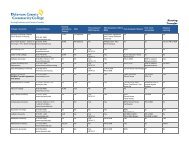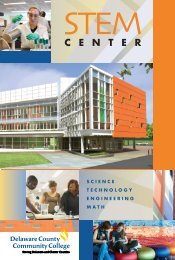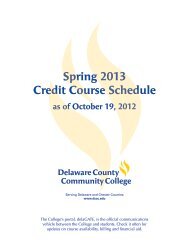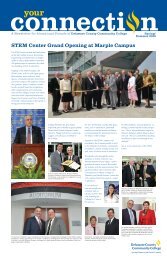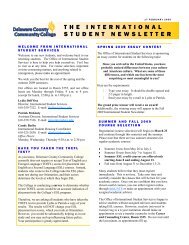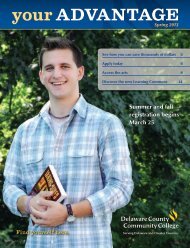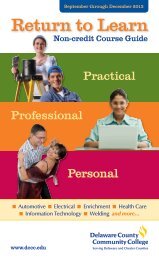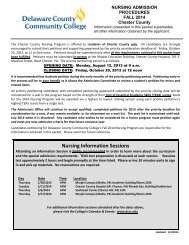2010 Catalog - Delaware County Community College
2010 Catalog - Delaware County Community College
2010 Catalog - Delaware County Community College
Create successful ePaper yourself
Turn your PDF publications into a flip-book with our unique Google optimized e-Paper software.
80 COURSE DESCRIPTIONS<br />
Upon successful completion of this course, students<br />
should be able to:<br />
• Identify important elements of ongoing data collection.<br />
• Describe essential steps in developing performancebased<br />
assessment programs.<br />
• Discuss techniques for comparing institutional<br />
performance to external performance data.<br />
• Relate JCAHO standards to institutional assessment and<br />
improvement initiatives.<br />
• Assess the value and purpose of the accreditation<br />
process and JCAHO accreditation standards.<br />
• Discuss current management concepts related to organizational<br />
performance measurement and improvement.<br />
• Consider the role of health care data/information<br />
management and health care databases as mechanisms<br />
for organizational performance measurement.<br />
• Review the development and focus of JCAHO's<br />
functional approach to performance measurement and<br />
improvement in health care organizations.<br />
• Explore current literature relevant to organizational<br />
performance improvement and accreditation issues.<br />
Prereq. AHA 209<br />
3 Credits 3 Weekly Lecture Hours<br />
(AHM) Allied Health Medical<br />
AHM 100<br />
Orientation to Health Care<br />
This course prepares students to understand the<br />
development and use of health care facilities within a<br />
community environment. The role of health care<br />
providers, the impact of socio-economic factors upon<br />
health care, health maintenance and the influence of<br />
technology upon health care are examined.<br />
Upon successful completion of this course, students<br />
should be able to:<br />
• Describe the major health care organizations and agencies<br />
and their role in the health care delivery systems.<br />
• Describe health care trends and economics.<br />
• Discuss common problems of health and diseases<br />
affecting the population.<br />
• Describe the basic organizational principles of a typical<br />
health care facility.<br />
• Identify and describe the role of members of the health<br />
care team.<br />
• Describe the communication and interpersonal skill<br />
required by health team members.<br />
• State the legal and professional responsibilities of allied<br />
health team members.<br />
3 Credits 3 Weekly Lecture Hours<br />
AHM 104<br />
Body Structure/Function I<br />
This course begins with an analysis of the structural<br />
foundation of the body and its ability to function<br />
integrating the levels of organization: chemical cellular,<br />
tissue, organ, and system. The course then emphasizes<br />
the anatomical structure, physiology, and selective disease<br />
processes specific to the integumentary, skeletal, muscular,<br />
lymphatic, circulatory, and respiratory systems. Mechanisms<br />
by which the body maintains fluid and electrolyte balance<br />
and acid base balance are also emphasized.<br />
Upon successful completion of this course, students<br />
should be able to:<br />
• Analyze the architectural plan of the human body as a<br />
whole, the organization of its functional units, and the<br />
mechanisms by which it performs its various activities.<br />
• Discuss the mechanism and patterns of disease-causing<br />
pathogens and neoplasms, and the body's response to<br />
threat of injury and disease.<br />
• Explain the function and interrelationship of fluids and<br />
electrolytes, the mechanisms by which the constancy of<br />
total body fluids is maintained, and regulation of the<br />
acid-base balance.<br />
• Describe the structure and function of the<br />
integumentary system and major disorders of<br />
this system.<br />
• Describe the structure and function of the skeletal and<br />
muscular systems as well as disorders of these systems.<br />
• Describe the structure and function of the circulatory and<br />
lymphatic systems as well as disorders of these systems.<br />
• Describe the structure and function of the respiratory<br />
system as well as disorders of this system.<br />
Coreq. AHM 233<br />
3 Credits 3 Weekly Lecture Hours<br />
AHM 105<br />
Body Structure/Function II<br />
This course emphasizes the anatomical structure,<br />
physiology, and selective disease processes specific to the<br />
digestive system, urinary system, nervous system and<br />
sense organs, endocrine system, and reproductive systems.<br />
How nutrition, growth, development, aging, and genetics<br />
influence body structure and function is also emphasized.<br />
Upon successful completion of this course, students<br />
should be able to:<br />
• Describe the structure and function of the digestive<br />
system as well as disorders of this system.<br />
• Describe adequate nutrition and the complex<br />
mechanism of metabolism, as well as disorders<br />
associated with eating and metabolism.<br />
• Describe the structure and function of the urinary<br />
system and major disorders of this system.<br />
• Describe the structure and function of the nervous<br />
system and disorders of this system.<br />
• Describe the mechanisms by which the sense organs<br />
are able to sense changes in our external and internal<br />
environments as a requirement for maintaining<br />
homeostasis; and diseases commonly affecting the<br />
sense organs.<br />
• Describe the structure and function of the endocrine<br />
system and major disorders of this system.<br />
• Describe the structure and function of the male and<br />
female reproductive systems, and briefly describe the<br />
major disorders inherent to these systems as well as<br />
the major disorders associated with pregnancy.<br />
• Describe the concept of development as a biological<br />
process characterized by continuous modification and<br />
change as well as the effects of aging on major body<br />
organ systems.<br />
• Describe genetics, the scientific study of inheritance,<br />
and its relationship to human disease.<br />
• Describe the physiology of congenital diseases and the<br />
roles that heredity and environmental factors play in the<br />
development of these conditions.<br />
Coreq. AHM 233<br />
3 Credits 3 Weekly Lecture Hours<br />
AHM 106 Medical Assistant<br />
Techniques and Practicum I<br />
This course is structured to prepare the student to assist<br />
the physician in the clinic, hospital or private office. The<br />
responsibilities include preparation of the client for examination,<br />
measurement of basic body functions, assistance<br />
in diagnostic testing and procedures, and general clinical<br />
procedures performed in the medical office.<br />
Upon successful completion of this course, students<br />
should be able to:<br />
• Understand the role and function of the medical<br />
assistant in the health care delivery system.<br />
• Evaluate the impact of disease and disease causing<br />
organisms on man and his environment.<br />
• Describe the role of the medical assistant in assisting<br />
with physical measurements.<br />
• Analyze the role of the medical assistant in<br />
assisting the physician with the health history and<br />
physical examination.<br />
• Understand the role of the medical assistant in the<br />
collecting and handling of specimens.<br />
• Analyze the role of the medical assistant in assisting<br />
the physician in minor surgery.<br />
• Understand the importance of nutrition, exercise, and<br />
diet therapy to the well being of the patient.<br />
• Students are eligible to enroll in this course only if they<br />
are able to complete the certificate requirements of the<br />
Medical Assistant program by the upcoming Summer I<br />
or Summer II semester.<br />
Prereq ENG 050, REA 050, MAT 040 or pass test<br />
4 Credits 3 Weekly Lecture Hours<br />
2 Weekly Laboratory Hours<br />
AHM 107 Medical Assistant<br />
Techniques and Practicum II<br />
The course prepares students to assist the physician in<br />
the clinic, hospital or private office. Responsibilities<br />
include preparation of the client for examination,<br />
measurements of body functions, aiding in diagnostic<br />
tests and procedures, and general operation of the office.<br />
Upon successful completion of this course, students<br />
should be able to:<br />
• Analyze the role and the responsibility of the medical<br />
assistant concerning the principles of pharmacology<br />
and drug administration.<br />
• Classify the commonly used diagnostic laboratory<br />
procedures that are utilized in a physician's office.<br />
• Classify the commonly used diagnostic radiological<br />
procedures that are utilized in the physician's office.<br />
• Describe the role of the medical assistant in the<br />
recording of an EKG.<br />
• Describe the role of the medical assistant in assisting<br />
with physical therapy.<br />
• Evaluate the role of the medical assistant during a<br />
medical emergency and giving first aid.<br />
Prereq. AHM 106<br />
4 Credits 3 Weekly Lecture Hours<br />
2 Weekly Laboratory Hours<br />
AHM 108<br />
Conditions of Illness<br />
The various conditions of human illness are reviewed.<br />
Symptomology, the body's response to disease, and<br />
diagnostic laboratory procedures specific to each disease<br />
are emphasized.<br />
Upon successful completion of this course, the student<br />
should be able to:<br />
• Understand the disease process and the treatment of pain.<br />
• Describe common infectious diseases and neoplasms.<br />
• Describe common congenital diseases and mental<br />
health disorders.<br />
• Describe the diseases that are common to the urinary,<br />
reproductive, and digestive systems.<br />
• Describe the diseases that are common to the<br />
respiratory, cardiovascular, and nervous systems.<br />
• Describe diseases that are common to the endocrine<br />
and musculoskeletal systems.<br />
• Describe common skin, eye, and ear disorders.<br />
Prereq. AHM 104 or 105 or BIO 150<br />
3 Credits 3 Weekly Lecture Hours<br />
AHM 109 Medical Assistant Review<br />
Practicum I<br />
This course is structured to provide the student with a<br />
review of the AHM 106 simulation laboratory experience<br />
in assisting the physician in the clinic, hospital or private<br />
office. Clinical skills covered include preparation of the<br />
client for examination, measurement of basic body<br />
functions, assistance in diagnostic testing and procedures,<br />
and general patient care procedures performed in the<br />
medical office.<br />
Upon successful completion of this course, students<br />
should be able to:<br />
• Understand the role and function of the medical<br />
DELAWARE COUNTY COMMUNITY COLLEGE




